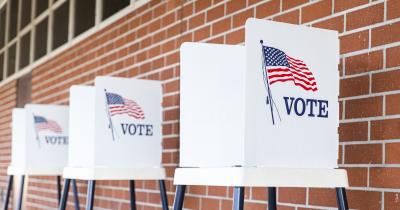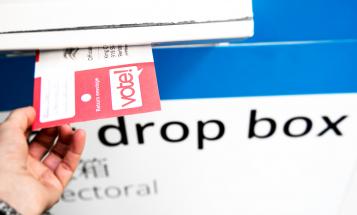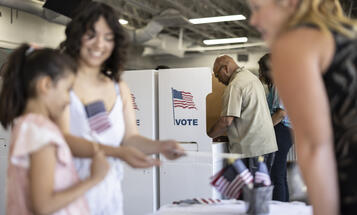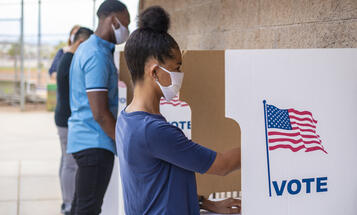
We Can Still Save Our Democracy Before November
Many state officials are stubbornly clinging to outdated, unsafe election procedures. For the health of our communities and our democracy, they should commit themselves to the three pillars of our voting rights agenda.

If there’s one thing we’ve learned since the COVID-19 crisis was officially declared a pandemic by the WHO on March 11, 2020, it’s that our elections are at grave risk.
These primaries were test cases—and failures.
In the 100 days since, 20 states and the District of Columbia have held primaries. We’ve seen voters unable to safely cast their ballots in Florida, faulty new voting equipment and limited polling stations in Georgia, long lines and thousands disenfranchised in Wisconsin, and a cumbersome vote-by-mail process that caused dismally low turnout in Ohio.
These primaries were test cases—and failures. Another test is tomorrow, June 23, with Kentucky and New York set to vote. Astonishingly, Kentucky plans to open just 200 of its usual 3,700 polling places, including a single location for Jefferson County, home to 767,000 residents and 44% of the state’s Black population.
A new political awakening is sweeping the nation. Yet many state officials are stubbornly clinging to outdated, unsafe election procedures and repeating the president’s agitprop against reform.
Uprisings against white supremacy and police brutality—ignited by the murders of George Floyd, Breonna Taylor, Ahmaud Arbery and other Black Americans—have spread across the country. A new political awakening is sweeping the nation. Yet many state officials are stubbornly clinging to outdated, unsafe election procedures and repeating the president’s agitprop against reform. Meanwhile, some governors have lifted stay-at-home orders without hitting critical benchmarks for testing and new cases, and health experts warn of a second wave of coronavirus in the fall, right in time for the general election.
States must act now, before it is too late. Here’s the voting rights agenda we must insist they undertake to ensure the health of our communities and our democracy in 2020:
1. We must eliminate barriers to voter registration.
First, we must eliminate barriers to voter registration. COVID-19 has derailed the usual methods of registering voters. Many states have closed DMVs and public benefits agencies, where roughly half of voter registrations occur. Voter engagement groups have been unable to go door-to-door or sign people up at malls, college campuses, and community events.
The unavailability of these strategies could frustrate efforts to close the registration gap for voters of color, 38% of whom were unregistered in 2016 compared to 26% of white voters. And it will make it harder to keep those who are registered on the rolls, as they move more frequently and are over-represented in voter purges. What does this mean for November? People of color will be disproportionately unregistered — entitled yet unable to vote.
To combat this, we must institute nationwide online voter registration (OVR). Most states allow OVR, but eight states refuse to come into the 21st century on this issue, including Texas with its 21 million voting-age citizens. Because of the continuing digital divide, states should also implement same-day registration (SDR), letting people register and vote on the same day. Although SDR has existed since the 1970s, only 21 states and D.C. offer it. Its availability increases voter turnout by 5% on average and could be even more impactful under pandemic conditions.
We must also protect the fundamental right to vote for eligible voters in jails and prisons, who are regularly disenfranchised through practices rooted in institutional racism. As noted recently in a report by Demos, many qualified, incarcerated voters are unaware that they are entitled to vote or unable to cast their ballots. We must prioritize increasing access to voter registration, ballots, and information for these voters.
2. We must make vote-by-mail (VBM) widely available and racially equitable.
Second, we must make vote-by-mail (VBM) widely available and racially equitable. VBM is a convenient, secure and commonsense solution at a time when many people cannot leave their homes and overcrowding the polls is dangerous. Increasingly vocal suggestions to the contrary only serve to scare people and suppress the vote. Over 31 million Americans voted by mail in 2018—more than one out of every four votes. Colorado, Hawaii, Oregon, Utah, and Washington state vote almost entirely by mail. In another 14 states, already between a quarter and 80% of voters cast mail ballots. Trump himself votes by mail, even as he seeks to stop others from doing so.
We should not only expand VBM, but also take down unnecessary hurdles to mail voting that disparately impact voters of color. In the 2018 midterms, Black and Latinx voters had their mail ballots rejected at more than twice the rate as white voters, due to purported signature match problems and other technical reasons. States should require training for officials evaluating signatures and provide an adequate “cure” process for voters to fix minor errors. They should stop requiring voters to get a witness or official notary to sign their ballot or to include a photocopy of their ID—steps most states don’t require and that are impossible for many in the midst of a pandemic. In Wisconsin’s primary, the witness signature requirement needlessly resulted in 11,944 ballots being invalidated for “insufficient certification.” This can’t happen again.
States should also affirmatively send postage-prepaid ballots to all registered voters. Requiring citizens to first submit applications complicates the process, requires multiple costly mailings, and results in people not getting their ballots in time to vote, as happened to many in Ohio and Georgia. The universal vote-by-mail states already do this. Maryland, Montana, Nevada, and New Jersey are doing so for their primaries. California will send mail ballots for the general.
But VBM is not a panacea. Mail doesn’t reach everyone. For instance, Native American voters living on reservations often do not have USPS addresses and must travel long distances to receive their mail. Black voters tend to have more frequent address changes and disproportionately experience homelessness. In Fulton County, Georgia, county officials reported that at least 8,000 mail-ballot applications were simply lost – contributing to higher than expected in-person voter turnout on Election Day. One county polling station reported an estimated 16,000 voters on June 9, which was triple the usual amount. In 2018, only 11% of Black voters nationally voted by mail, compared to 23% of white voters. Indeed, voting in person is an important tradition for many voters of color. And voters with disabilities and those with limited English proficiency often need to vote in person to use accessible voting machines and translation services.
3. We must preserve and increase in-person voting options.
For these reasons, finally, we must preserve and increase in-person voting options. Milwaukee, home to 60% of Wisconsin’s Black voters, opened only five of its 180 polling locations, resulting in long lines and crowding at the polls. Many voters who hadn’t received ballots in the mail simply could not vote in person under those conditions. At least 67 people contracted COVID-19 in Milwaukee after going to the polls.
The solution is to guarantee early voting, expand the number of polling locations, and institute curbside or drive-through balloting to space out voting and reduce density on Election Day. Having options is especially important for frontline workers, who are disproportionately people of color and have less flexible work schedules and greater risk for infection.
These structural reforms are essential for racially equitable elections. They are also pro-voter reforms designed to help all citizens exercise their fundamental right. As we all hope for a day when COVID-19 no longer threatens our lives, we must work to ensure it does not upend our democracy.




